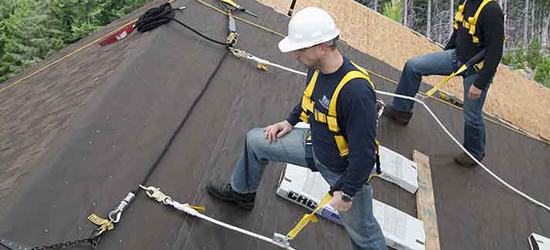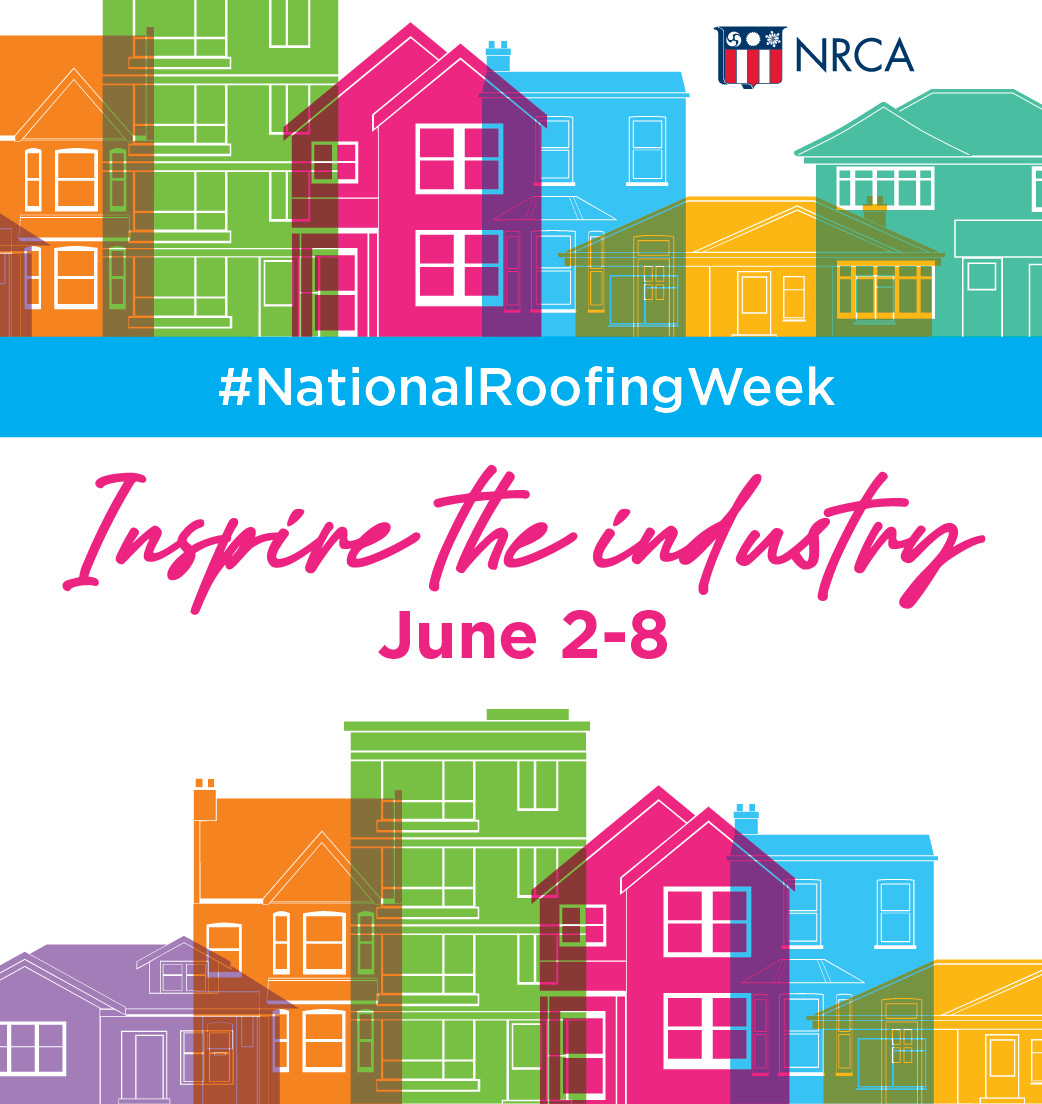Reducing Falls During Residential Construction: Re-Roofing

Courtesy of OSHA and WSRCA.
Re-roofing exposes workers to the hazards of demolition work at heights.
With the proper fall protection, the risk of serious falls can be substantially reduced. This fact sheet highlights some of the hazards workers encounter during re-roofing and lists some practical methods employers can use to protect workers who replace roofs. The fall protection methods in this fact sheet may not be suitable in all situations. Employers are responsible for ensuring compliance with applicable OSHA requirements.
Risks During Re-Roofing
Workers replacing roofs risk permanent injury or death from falls while they demolish old roofs and install new roofing material (for example, shingles, tiles, or slate). Even experienced roofers are exposed to unpredictable fall hazards caused by uneven sheathing, sudden gusts of wind, loose roofing materials, and surfaces that become slick when wet. Taking appropriate fall protection measures reduces risks and saves lives.
The employer must provide a training program for each worker who might be exposed to fall hazards. The program must enable each worker to recognize the hazards of falling and train each worker in the procedures to follow to minimize these hazards. For fall protection training requirements, refer to 29 CFR 1926.503. In all cases, employers must evaluate the hazards and take measures to reduce the risk of falls.
More than one-third of fall deaths in residential construction are caused by falls from roofs.
Safe Roofing Practices: Important Steps
Before beginning the job, focus on identifying fall protection needs. Survey the roof to determine if there are pre-installed anchorages available that can be used. If not, then plan immediately to identify those systems needed to protect workers from falls and have them in place before the workers report to the job.
Reducing Risks: Determining Structural Integrity
Many workers have been injured when the roofs they were working on collapsed from under them. Employers must determine the structural integrity of the roof and take all necessary precautions to protect the workers before the job begins (29 CFR 1926.501(a)(2)). If workers notice signs of structural deterioration (for example, dry rot), a competent person should evaluate the area.
Other considerations for a safe construction site:
- Guard against falls through skylights or other roof openings. Use a guardrail system, a personal fall arrest system (PFAS), or a protective cover that will support two times the weight that may be imposed on it at any one time. For additional information on protecting workers around skylight and other roof openings, refer to 29 CFR 1926.501(b)(4) and 29 CFR 1926.502(i).
- Appropriate footwear is important personal protective equipment on any construction site, but it is critical during roof demolition. A nail or shingle-removal tool injury can cause a worker to lose concentration and fall.
- Workers should be careful of air hoses and power cords for nail guns and other electrical equipment. If a worker steps on one, hoses and cords can slip underfoot and lead to falls.
Staging Material
Loose material and hand-held equipment can create tripping hazards on the roof surface. To minimize exposure to fall hazards, employers can stage materials so that workers on the roof have quick and safe access to them. While handling material on the roof, the worker should hold the material on the side of his or her body that faces the down-sloped edge to prevent being struck by the materials if they are dropped. Material can also be staged so it cannot slide off the roof edge and potentially strike a worker on the ground. Slide guards can help to keep material from sliding off the roof. Establishing a restricted area around the perimeter of the project can also keep workers out of the danger zone where debris, tools or materials may fall to the ground. The area should be posted with signs that warn of the potential hazard.
Protect Workers on the Ground
During the demolition phase, protect workers on the ground from falling debris by controlling how debris leaves the roof. Consider using an all-terrain forklift to elevate a disposal box to the roof level. This method makes cleanup after the job particularly easy.
Using the Right Equipment
Employers must provide roofers fall protection equipment that meets OSHA requirements whenever they work 6 feet or more above a lower level. There are fall protection systems available that can provide roofers the flexibility they need during demolition and roof installation. Some are more efficient than others because, in many cases, the employer can use the same system for both processes. Each phase of roof replacement has different challenges, but the risk of falling remains constant. Contractors may be able to protect their workers using the following equipment:
- Personal fall arrest systems;
- Guardrails; or
- Ladders
Note: Fall protection requirements for residential construction work performed on ladders are in Subpart X, not in 29 CFR 1926.501(b)(13).
Providing Fall Protection for the Whole Job
Personal fall arrest system: A PFAS is a tool available to roofers during replacement jobs. In fact, a PFAS is the system of choice for many roofers. However, a breakdown in any component of a PFAS could be disastrous for a worker. Always follow the manufacturer’s instructions on selecting, installing and using PFAS components correctly. Some PFASs include special elevated anchor assemblies that permit the system to protect workers even when they stand near the anchor locations. Certain anchorage assemblies rotate or offer extension arms to improve mobility and prevent lifelines from contacting the roof surface. This is particularly useful during roof demolition when a line could catch on a nail or debris.
Personal Fall Arrest System (PFAS)
A PFAS is designed to safely stop a fall before the worker strikes a lower level. It includes three major components:
- An anchorageto which the other components of the PFAS are rigged.
- A full body harnessworn by the worker.
- A connector, such as a lanyard or lifeline, linking the harness to the anchorage. A rip-stitch lanyard, or deceleration device, is typically a part of the system.
Horizontal lifeline: An engineered horizontal lifeline system, when used as part of a PFAS, is another way to increase the area in which a worker is protected. Install the system following the manufacturer’s instructions and under the supervision of a qualified person. Horizontal lifelines must be designed to maintain a safety factor of at least two (twice the impact load). For requirements for horizontal lifelines, refer to 29 CFR 1926.502(d)(8).
Rope grabs: Instead of attaching themselves to a fixed anchor, workers may be able to use adjustable rope grabs, another available component of a PFAS. This inexpensive and very popular system is the fall protection system of choice for many roofers. Rope grabs allow workers to adjust the length of the lifeline and can be useful when workers are moving about the roof frequently. The anchored ropes can be as long as necessary, making this form of fall protection highly versatile. Roofers who use rope grabs need to constantly take up the slack out of the line. Too much slack could allow a worker to free fall more than six feet off the roof if they slip. Training and monitoring are critical to the safe use of rope grabs.
Fall Restraint: While fall restraint systems are not mentioned in OSHA’s fall protection rules, OSHA will accept a properly utilized fall restraint system instead of a personal fall arrest system when the restraint system is rigged so that the worker cannot get to the fall hazard. In effect, (if properly used) the system tethers a worker in a manner that will not allow a fall of any distance. A fall restraint system is comprised of a body belt or body harness, an anchorage, connectors, and other necessary equipment. Other components typically include a lanyard, and may also include a lifeline and other devices.
Always follow the manufacturer's instructions or consult a qualified person to ensure proper installation of anchor points. Fall restraint may be a viable way to provide fall protection in situations in which the employer has concerns about the adequacy of available anchorage points for fall arrest equipment.
Temporary guardrails: Removeable guardrail systems can offer roofers effective protection when installed around the roof perimeter. Always follow the manufacturer’s instructions or consult a qualified person, as defined by 29 CFR 1926.32(m), for proper guardrail installation. This person could be the owner, the supervisor, or any other worker who has extensive knowledge, training and experience with fall protection and is able to solve problems relating to fall protection. For requirements requirements for guardrails, refer to 29 CFR 1926.502(b)- Guardrail Systems.
Other considerations: Some employers have found success in eliminating fall hazards by using scaffolds and aerial lifts when site conditions permit their use. Fall protection requirements performed on scaffolds and aerial lifts can be found in 29 CFR 1926 Subpart L – Scaffolds.
Attaching Anchors
OSHA requires that anchors for PFASs be able to hold at least 5,000 pounds of weight per person or maintain a safety factor of at least two (twice the impact load) under the supervision of a qualified person. Always follow the manufacturer’s instructions or consult a qualified person when installing anchors to ensure they are strong enough to hold the sudden weight of a falling worker. OSHA believes that anchorages available on the market will meet the strength requirements if they are installed as per the manufacturer’s instructions, with the right number of properly sized nails or screws through the roof sheathing and into one or more roof trusses.
When choosing an anchor to use for fall protection, employers have a number of options; for example,
- Peak anchor: At the top of the roof, peak anchors are typically solid, non-moving pieces secured to the trusses underneath.
- Permanent D-rings: Inexpensive D-ring anchors can be attached to the truss frame; they can be left permanently on the roof for future use.
Install an anchor above the area being built: Choose an anchor that is appropriate for the type of roof and anchor location. Depending on the roof design, the best location might be at the peak of the roof, directly over a truss.
Consider leaving anchors in place: Where practical, employers may consider leaving anchors in place. This can make the current job simpler and reduce the burden for roofers in the future.
Written Fall Protection Plans
When working at heights of 6 feet or greater, if the employer does not use ladders, scaffolds, aerial lifts or fall restraint systems and can demonstrate that it is not feasible or would create a greater hazard to use conventional fall protection equipment (guardrails, safety nets or PFAS), the employer must develop a written site-specific fall protection plan in accord with 29 CFR 1926.502(k). The plan must be prepared by a qualified person. This person could be the owner, the supervisor, or any other worker who has extensive knowledge, training and experience with fall protection and is able to solve problems relating to fall protection.
The site-specific fall protection plan must document, for each location, why the use of conventional fall protection equipment is not feasible or will create a greater hazard. The plan must also describe the alternative methods that the employer will use so that workers are protected from falls. Workers and their supervisors must be trained on the proper use of those other fall protection methods.
Conventional fall protection equipment can reduce or eliminate the chances of a fatal fall. Otherwise, a written site-specific fall protection plan ensures that protection continues, even when conventional fall protection methods are determined to not be feasible.
---
OSHA Standard:
29 CFR 1926 Subpart M – Fall Protection
Available online at www.osha.gov/pls/oshaweb/owadisp.show_document?p_table=STANDARDS&p_id=10922.
OSHA Residential Fall Protection Web Page: www.osha.gov/doc/topics/residentialprotection/ index.html.
OSHA Compliance Guidance:
Compliance Guidance for Residential Construction – STD 03-11-002 (dated 12/16/2010)
Available online at www.osha.gov/pls/oshaweb/owadisp.show_document?p_table=DIRECTIVES&p_id=4755.
State Plan Guidance: States with OSHA-approved state plans may have additional requirements for Residential Roofing. For more information on these requirements, please visit:www.osha.gov/dcsp/osp/statestandards.html.
Help for Employers: OSHA's On-site Consultation Program offers free and confidential advice to small and medium-sized businesses in all states across the country, with priority given to highhazard worksites. On-site Consultation services are separate from enforcement and do not result in penalties or citations. Consultants from state agencies or universities work with employers to identify workplace hazards, provide advice on compliance with OSHA standards and assist in establishing injury and illness prevention programs. To locate the OSHA Consultation Program nearest you, call 1-800-321-OSHA (6742) or visit www.osha.gov/dcsp/smallbusiness/consult.html.
Almost every OSHA area office has a Compliance Assistance Specialist to assist employers in complying with OSHA standards. To find the Compliance Assistance Specialist nearest you, call 1-800-321-OSHA (6742) or visit: www.osha.gov/html/RAmap.html.
Editor’s note: This first published on WSRCA’s Roof Talk and can be viewed here.
LEGAL DISCLAIMER
All rights reserved. All content (text, trademarks, illustrations, reports, photos, logos, graphics, files, designs, arrangements, etc.) in this Technical Opinion (“Opinion”) is the intellectual property of Western States Roofing Contractors Association (WSRCA) and is protected by the applicable protective laws governing intellectual property. The Opinion is intended for the exclusive use by its members as a feature of their membership. This document is intended to be used for educational purposes only, and no one should act or rely solely on any information contained in this Opinion as it is not a substitute for the advice of an attorney or construction engineer with specific project knowledge. Neither WSRCA nor any of its, contractors, subcontractors, or any of their employees, directors, officers, agents, or assigns make any warranty, express or implied, or assumes any legal liability or responsibility for the accuracy, completeness, or any third party’s use (or the results of such use) of any information or process disclosed in the Opinion. Reference herein to any general or specific commercial product, process or service does not necessarily constitute or imply its endorsement or recommendation by WSRCA. References are provided as citations and aids to help identify and locate other resources that may be of interest, and are not intended to state or imply that WSRCA sponsors, is affiliated or associated with, or is legally responsible for the content reflected in those resources. WSRCA has no control over those resources and the inclusion of any references does not necessarily imply the recommendation or endorsement of same.








-2.png)









Comments
Leave a Reply
Have an account? Login to leave a comment!
Sign In